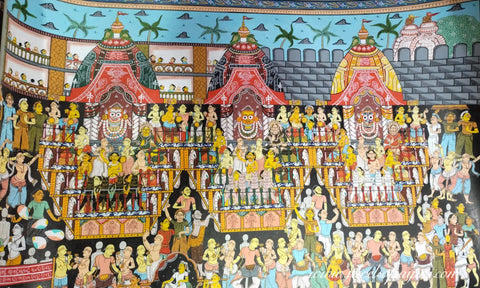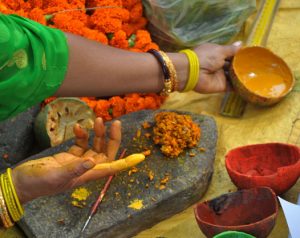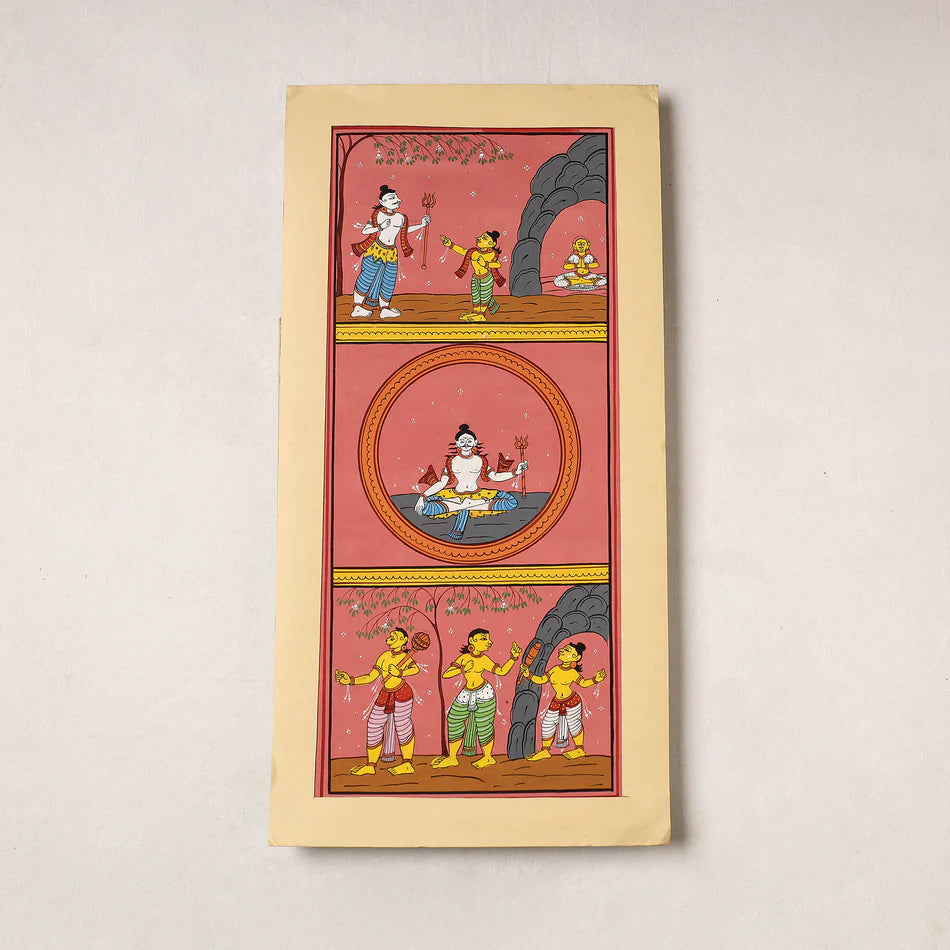Origin
The term Patachitra is derived from the Sanskrit words 'Patta' (cloth) and 'Chitra' (image), meaning cloth-based painting. This art form, one of the most ancient and well-known contemporary art forms, is said to have developed in the 12th century.
Pattachitra painting is a broad category for traditional, cloth-based painting, which is prominent in the eastern Indian states of Orissa, West Bengal, and a few parts of Bangladesh. Patachitra art is recognized for its unique detailing and the mythical folktales engraved in it. Pattachitra paintings and teaching this art form is a custom passed down through generations in the form of a family sketchbook, which is valued as a precious asset. These paintings are still highly demanded and sold in all unique collective handicraft stores.

Lord Shri Krishna Lila in Patachitra of Odisha
Uniuqueness of the painting:-
Patachitra is a canvas painting that portrays most mythological characters. Pattachitra is a canvas painting that portrays most mythological characters. It stands out due to its rich colors, intricate details and designs, and presentation of simple and elegant themes. The repetitive designs and patterns give the paintings a geometric aspect. The chitrakaars' paintings are typically highly defined, and repetition as a style gives a significant visual appeal. Another distinguishing element of the paintings is the lack of depth or perspective interpretation, giving them a two-dimensional appearance. It is also used to make lovely art pieces by experimenting with various items and spaces. Similar techniques and styles are known as 'Bhatti Chitras' when used on walls, and 'Tala Pata Chitras' on palm leaves.
Religious paintings and Vishnu temples:-
Patachitra paintings illustrating Indian mythology (The Ramayanas, Puranas, etc.) and the temple of Lord Jagannath are carved on the walls of the localities rather than on plain cloths or canvases.
During the Hindu festival of Rath Yatra, when Lord Jagannath and his siblings go into hibernation, and thus the deities' Pattachitra paintings are worshipped. The painters begin the paintings a couple of weeks before the hibernating period begins. The "trinity" of Nilamadhava (Jagannath), Ananta (Balaram), and Bhubhaneswari (Subhadra) is worshipped in three major Patachitra made by the temple's folk artists. The story of these three siblings was first told on Pattachitra. These deities are dressed in black, white, and yellow. The two huge eyes represent the sun and moon.

{Image source:- jewelsofsayuri}
The five major colors, known as Pancha-Tatwa, have relevance in the main painting of Jagannath. The colors also represent each character's Rasa in a tale. Hasya, or laughing, is depicted in white, Raudra, or rage, in red, and Adbhuta, or amazement, in yellow.
Similarly, Lord Krishna is shown in blue and Lord Rama in green. Mixing these primary colors creates around 120 more colors. The colors are mixed in wooden cups made of coconut shells, a natural product. Mouse hair is used to make fine brushes. Coarse brushes are made from buffalo hair and keya roots.
Making:-
Making this as pretty as a picture painting involves several steps-
1.Preparing the canvas - Pattachitra paintings are done on a cotton canvas(pata). The canvas is made by immersing cotton in a mixture of crushed imli seeds and water for 4-5 days. The fabric is then removed and dried in the sun. After that, powdered seashells are soaked and heated to produce white color (a milky paste). This paste is put on both sides of the layered fabric and sun-dried. When dried, khaddar stone is rubbed over the canvas multiple times to smooth it out. Once the canvas is smooth, the chikana stone is rubbed over it to bring shine to it

{Image source - D'source }
2.Preparing the color- In today’s time, painters prefer using readily available paints from the market. However, in ancient times the colors were derived from natural resources. Such as, black color was obtained from lampblack ie, Placing an earthen plate over the flames of a lit candle. Green is made up of green plants and green stones. Hingula, an indigenous stone found in Orissa, is powdered to make red. Harital, another native stone, is used to make yellow. The blue color is made from another stone called Khandaneela.

{Image source - patachitra}
3.Finally bringing it all together- Borders are an important portion of the painting and are first made on the canvas on all four sides. The figurines are sketched with a pencil and then the body colors are painted, followed by their attire and background. After the painting is finished, the figure is outlined in black.

{Image source - D'source }
4.Coating the painting - A generous layer of lacquer coating is applied to the painting (made from resin seeds). This procedure, known as Jaulasa, preserves the artwork while also providing a beautiful gloss.
Pattachitra in modern times:-
The painting style has seen many cultural changes through the years. 'Pattachitra' is a highly disciplined type of art. Several artists have instilled creativity in the art genre over the years. However, the themes, which include vibrant colors and representations of mythological stories, have not changed. Painting technology is still the same as it was earlier. The core distinction is that the painters favor mouse-haired brushes for more intricate work.

Canvas paintings are made mainly for religious purposes. Patachitra on Tussar silk wall hangings is quite popular in a new market.
A family's generation of artists frequently practices this artistry. The old lineage of painters used to reside around temples that hired them to create paintings for worship. Patachitra's artists have been experimenting with various materials and concepts. Patachitra is regarded as a significant cultural treasure in temples, a unique collectable in the form of invitation cards or a feature.
To buy these unique Patachitra paintings that can make any corner of your house lively and can also be used in the home Mandir, go checkout the best handicraft store in India! We have a range of products from home decor paintings to beautiful hand painted kitchenware.
Having kitchenware and home decor of the themes of Patachitra will make your home more appealing and make you feel closer to your roots !
Blogs you might also like:
Jaipur markets
Know Your Handlooms
Abdul kumbar - khavda art
REFERENCES
https://www.worldartcommunity.com/blog/2022/05/the-story-of-pattachitra/
https://bit.ly/3pLPH4T
https://www.dsource.in/gallery/patachitra-painting-orissa
 Verified Purchase
Verified Purchase
























Leave a comment (all fields required)